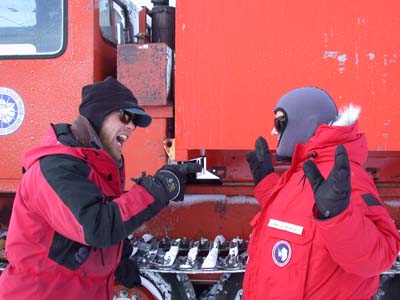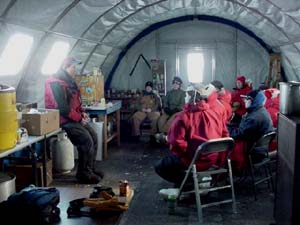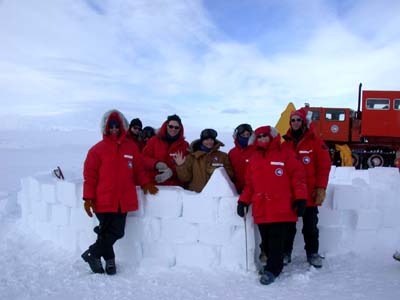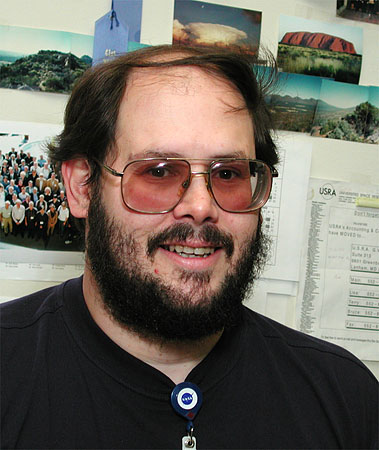TIGER in Antarctica
November 14, 2001
Happy Camper School, Day 2
 OK, so what is it like to sleep out in Antarctica? With the right equipment, it's not so bad. First, I was wearing two sets of long winter underwear (one thin, one thick), and polar-fleece shirt and pants over that. I had just put on a new dry pair of thick wool socks. I also wore a cap, because I quickly realized I needed one after lying down to sleep. A down sleeping bag with polar-fleece liner, and two foam pads beneath me worked fine. I also had a bottle of hot water (taken from what was left in the pots used for supper) at the foot of my sleeping bag. I felt cozy and warm most of the night. The one problem I had was when moisture condensed on the ceiling and dripped down right on my face, which was the only part exposed. While I wasn't cold, I also wasn't very comfortable. We hadn't spent time leveling out the snow beneath the tent and it was bumpy and hard. Plus, I don't normally sleep on my back, which was really the only way to sleep in this set up.
OK, so what is it like to sleep out in Antarctica? With the right equipment, it's not so bad. First, I was wearing two sets of long winter underwear (one thin, one thick), and polar-fleece shirt and pants over that. I had just put on a new dry pair of thick wool socks. I also wore a cap, because I quickly realized I needed one after lying down to sleep. A down sleeping bag with polar-fleece liner, and two foam pads beneath me worked fine. I also had a bottle of hot water (taken from what was left in the pots used for supper) at the foot of my sleeping bag. I felt cozy and warm most of the night. The one problem I had was when moisture condensed on the ceiling and dripped down right on my face, which was the only part exposed. While I wasn't cold, I also wasn't very comfortable. We hadn't spent time leveling out the snow beneath the tent and it was bumpy and hard. Plus, I don't normally sleep on my back, which was really the only way to sleep in this set up.
Photo on right: My tent for the night
 We did not get ready to sleep until about 10:30. And it didn't seem so weird that it was still bright as noon when we went to sleep. But waking up a 2:30 AM and having the sunlight pouring into the thin tent was a little strange.
We did not get ready to sleep until about 10:30. And it didn't seem so weird that it was still bright as noon when we went to sleep. But waking up a 2:30 AM and having the sunlight pouring into the thin tent was a little strange.
Photo on left: Inside the mountaineering tent
My spare clothes, gloves, and socks were between my sleeping bag liner and sleeping bag so they would be reasonably warm in the morning. My gloves had gotten quite wet from all the work I had done the day before, and by morning they were frozen solid. I woke up at 6 AM, and the whole rest of the camp is quiet. I put on new gloves, but they are nowhere near as good as the original ones and my hands are painfully cold. I find glove liners, and after I've been moving for a little while, my hands finally warm up.
No one else is awake yet, so I go for a little walk along a flagged path, staying withing sight of the camp, since I'm not supposed to be out by myself. I take a > 360 degree panorama (using many individual shots) that I've put together here (Note: the full panorama is very large):

Hopefully, I'll get to annotate it so you can identify the terrain features.
 By the time I get back, others are waking up. We're supposed to give a radio check to the instructor at 8 AM, and he's coming with the Nodwell at 9 AM, by which point the camp is supposed to be mostly torn down. We get the stoves going, and boil water for hot drinks and hot oatmeal (which is amazingly good when you're cold). By 8:30, we still have not seen the Kiwis (New Zealanders) who are sleeping in the ice mound, and one of them has the radio and was supposed to have called in. I check them out and get the radio tossed out of the mound with a request that I handle it. They hadn't gotten to sleep until after four and were a little slow getting up.
By the time I get back, others are waking up. We're supposed to give a radio check to the instructor at 8 AM, and he's coming with the Nodwell at 9 AM, by which point the camp is supposed to be mostly torn down. We get the stoves going, and boil water for hot drinks and hot oatmeal (which is amazingly good when you're cold). By 8:30, we still have not seen the Kiwis (New Zealanders) who are sleeping in the ice mound, and one of them has the radio and was supposed to have called in. I check them out and get the radio tossed out of the mound with a request that I handle it. They hadn't gotten to sleep until after four and were a little slow getting up.
Photo on right: Instructor Ted teaching Garry some of the finer points
 Ted picks us up a little after 9, and after putting all the gear away, it's back into the instructor hut for more lessons. The first thing we talk about is how everyone slept. On a scale of 1 to 10, different people rate their night from as low as 2, and all the way up to 10. I'm a 6 or 7, mostly for comfort, not for cold. But some people were very cold and uncomfortable, and others slept like logs. Then we rate the freeze dried dinners. It turns out that what I (and several others) had "Chicken and Brown Rice" is widely considered one of the worst. It was quite bland. We suspect that the reason so many of us had the worst of the meals was that the instructors had already removed the best (Sierra Chicken) for personal use :-)
Ted picks us up a little after 9, and after putting all the gear away, it's back into the instructor hut for more lessons. The first thing we talk about is how everyone slept. On a scale of 1 to 10, different people rate their night from as low as 2, and all the way up to 10. I'm a 6 or 7, mostly for comfort, not for cold. But some people were very cold and uncomfortable, and others slept like logs. Then we rate the freeze dried dinners. It turns out that what I (and several others) had "Chicken and Brown Rice" is widely considered one of the worst. It was quite bland. We suspect that the reason so many of us had the worst of the meals was that the instructors had already removed the best (Sierra Chicken) for personal use :-)
Photo on left: Do I look cold?
 Then we get training in how to use the different types of radios, including the large set that is used at most remote sites. A quick lunch and then it's back outside to really set up the radio with its large wire antenna. We get McMurdo easily, and then try to reach Amundsen-Scott Station at the South Pole. Very quickly we pick them up loud and clear, but they sound pretty busy, so we keep it short. Then we all climb into the Nodwell and are told to get ready for a "scenario", i.e. final exam! We assign key roles; communications, tents, stoves, medical, etc., including alternates and what we move to after our primary job is done.
Then we get training in how to use the different types of radios, including the large set that is used at most remote sites. A quick lunch and then it's back outside to really set up the radio with its large wire antenna. We get McMurdo easily, and then try to reach Amundsen-Scott Station at the South Pole. Very quickly we pick them up loud and clear, but they sound pretty busy, so we keep it short. Then we all climb into the Nodwell and are told to get ready for a "scenario", i.e. final exam! We assign key roles; communications, tents, stoves, medical, etc., including alternates and what we move to after our primary job is done.
Photo on right: Inside the instructors' hut
 Then Ted comes back and tells us our Nodwell is really a C-130 Hercules that has gone down on the ice and we've got to deal with it. We have to set up two tents, two stoves and a snow wall protecting them from the wind, the radio and "deal with anything else that might happen". I set up the radio with a guy who was a communications specialist in the military. We quickly get it up and "contact" McMurdo Station. Then I move to help with the tents (they still won't let me near the stoves). We're almost done when we notice that Ted is a ways away, down on the ground crawling without his parka and gloves. "Man down!" and we go rushing to help. Wow, a final exam where if you fail, the teacher dies :-) We quickly determine that he has the "umbles"; mumbling, stumbling, fumbling, and grumbling, which is the sign of moderate hypothermia. We have to get him warm. We put back on his outer layers, pick up one of the tents and move it over to him, and get him something hot to drink. He's OK!
Then Ted comes back and tells us our Nodwell is really a C-130 Hercules that has gone down on the ice and we've got to deal with it. We have to set up two tents, two stoves and a snow wall protecting them from the wind, the radio and "deal with anything else that might happen". I set up the radio with a guy who was a communications specialist in the military. We quickly get it up and "contact" McMurdo Station. Then I move to help with the tents (they still won't let me near the stoves). We're almost done when we notice that Ted is a ways away, down on the ground crawling without his parka and gloves. "Man down!" and we go rushing to help. Wow, a final exam where if you fail, the teacher dies :-) We quickly determine that he has the "umbles"; mumbling, stumbling, fumbling, and grumbling, which is the sign of moderate hypothermia. We have to get him warm. We put back on his outer layers, pick up one of the tents and move it over to him, and get him something hot to drink. He's OK!
Photo on left: The whole Happy Camper team
We pass, although we could have done better. You shouldn't move someone with severe hypothermia because it can actually cause heart fibrillation (a heart attack). But with moderate hypothermia, with the patient still moving somewhat on their own, getting them moving around will help them recover.
Then back into town. A successful, fun, experience with some great people.

Dr. Eric R. Christian
Eric's Featured Scientist Profile
This page was last modified on December 19,
2002
|
|
|